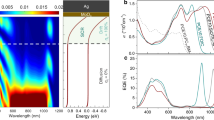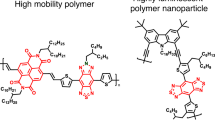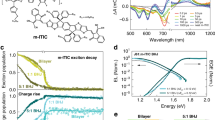Abstract
THE photovoltaic effect involves the production of electrons and holes in a semiconductor device under illumination, and their subsequent collection at opposite electrodes. In many inorganic semiconductors, photon absorption produces free electrons and holes directly1. But in molecular semiconductors, absorption creates electroná¤-hole pairs (excitons) which are bound at room temperature2, so that charge collection requires their dissociation. Exciton dissociation is known to be efficient at interfaces between materials with different electron affinities and ionization potentials, where the electron is accepted by the material with larger electron affinity and the hole by the material with lower ionization potential3. A two-layer diode structure can thus be used, in which excitons generated in either layer diffuse towards the interface between the layers. However, the exciton diffusion range is typically at least a factor of 10 smaller than the optical absorption depth, thus limiting the efficiency of charge collection3. Here we show that the interpenetrating network formed from a phase-segregated mixture of two semiconducting polymers provides both the spatially distributed interfaces necessary for efficient charge photo-generation, and the means for separately collecting the electrons and holes. Devices using thin films of these polymer mixtures show promise for large-area photodetectors.
This is a preview of subscription content, access via your institution
Access options
Subscribe to this journal
Receive 51 print issues and online access
$199.00 per year
only $3.90 per issue
Buy this article
- Purchase on Springer Link
- Instant access to full article PDF
Prices may be subject to local taxes which are calculated during checkout
Similar content being viewed by others
References
Bube, R. H. Photoelectronic Properties of Semiconductors (Cambridge Univ. Press, 1992).
Pope, M. & Swenberg, C. E. Electronic Processes in Organic Crystals (Clarendon Press, Oxford, 1982).
Tang, C. W. Appl. Phys. Lett. 48, 183–185 (1986).
Burroughes, J. H., Jones, C. A. & Friend, R. H. Nature 335, 137–141 (1988).
Burroughes, J. H. et al. Nature 347, 539–541 (1990).
Moratti, S. C. et al. SPIE proc. ser. 2144, 108–114 (1994).
Greenham, N. C., Moratti, S. C., Bradley, D. D. C., Friend, R. H. & Holmes, A. B. Nature 365, 628–630 (1993).
Braun, D. & Heeger, A. J. Appl. Phys. Lett. 58, 1982–1984 (1991).
Jones, R. A. L. Physics World 8(3), 47–51 (1995).
Schlenoff, J. B., Obrzut, J. & Karasz, F. E. Phys. Rev. B40, 11822–11833 (1989).
Morita, S., Zakhidov, A. A. & Yoshino, K. Solid St. Commun. 82, 249–252 (1992).
Sariciftci, N. S., Smilowitz, L., Heeger, A. J. & WudI, F. Science 258, 1474–1476 (1992).
Greenham, N. C. et al. Chem. Phys. Lett. 241, 89–96 (1995).
Halls, J. J. M., Friend, R. H. & Holmes, A. B. Syntn. Metals (in the press).
Marks, R. N., Halls, J. J. M., Bradley, D. D. C., Friend, R. H. & Holmes, A. B. J. Phys. condensed Matter 6, 1379–1394 (1994).
Yu, G., Zhang, C. & Heeger, A. J. Appl. Phys. Lett. 64, 1540–1542 (1994).
Riess, W., Karg, S., Dyakonov, V., Meier, M. & Schwoerer, M. J. Lumin. 60/61, 906–911 (1994).
Antoniadis, H., Hsieh, B. R., Abkowitz, M. A., Jenekhe, S. A. & Stolka, M. Syntn. Metais 82, 265–271 (1994).
Borsenberger, P. M. & Weiss, D. S. Organic Photoreceptors for Imaging Systems (Dekker, New York, 1993).
Berggren, M., et al. Nature 372, 444–446 (1994).
Yang, Y. & Heeger, A. J. Nature 372, 344–346 (1994).
O'Regan, B. & Grätzel, M. Nature 353, 737–740 (1991).
Schiebel, U. et al. SPIE proc. ser. 2163, 129–140 (1994).
Yu, G. & Heeger, A. J. J. appl. Phys. (in the press).
Author information
Authors and Affiliations
Rights and permissions
About this article
Cite this article
Halls, J., Walsh, C., Greenham, N. et al. Efficient photodiodes from interpenetrating polymer networks. Nature 376, 498–500 (1995). https://doi.org/10.1038/376498a0
Received:
Accepted:
Issue Date:
DOI: https://doi.org/10.1038/376498a0
This article is cited by
-
Physical insights into non-fullerene organic photovoltaics
Nature Reviews Physics (2024)
-
Organic photodiodes with bias-switchable photomultiplication and photovoltaic modes
Nature Communications (2023)
-
Phenanthroline-carbolong interface suppress chemical interactions with active layer enabling long-time stable organic solar cells
Nature Communications (2023)
-
Advantages, challenges and molecular design of different material types used in organic solar cells
Nature Reviews Materials (2023)
-
Key molecular perspectives for high stability in organic photovoltaics
Nature Reviews Materials (2023)
Comments
By submitting a comment you agree to abide by our Terms and Community Guidelines. If you find something abusive or that does not comply with our terms or guidelines please flag it as inappropriate.



